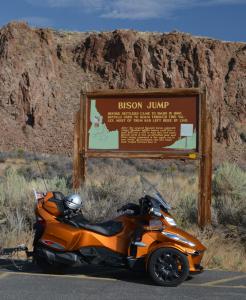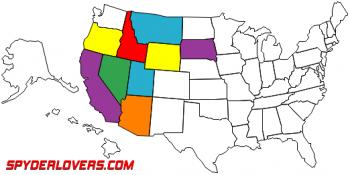|
-
Very Active Member


 Originally Posted by Peter Aawen

Just to expand a little on that - most of those gauges are within about 50% of accurate OR somewhat accurate 50% of the time....  But you'll never know which or when! 
This is basically due to the irregular shape of the tank & the location of the pump/sender in the tank, so while you might get a slight improvement in accuracy by installing or using a new/different/more accurate gauge, at best it's indication is only ever gonna be a somewhat vague indicator of what gas might be remaining in the tank!! 
So just like most of the rest of us, use your trip meter & fill up based on how far you've travelled since you last filled!  . Just Reset a trip meter every time you fill up, do a few rough calculations to work out what your best & worst fuel economy might be so you can work out your average range on a tank of gas, then always try to fill up before you hit that worst case scenario! 
These engines & their fuel pumps/injector systems REALLY don't like running too low on gas, because the gas remaining in the tank serves as both lubricant & coolant for those fairly critical components. So ideally you'll ALWAYS keep at least a couple of quarts/litres remaining in the tank - any less gas than that remaining in the tank risks expensive damage to the pump &/or injector system, and even if you think you might've got away with it on that one time you ran your gas lower than that, you'll probably never really know until one day the fuel pump &/or engine craps out on you when you least want it to!! 
Don't rely on the gas gauge, and always aim to refill while there's still at least a couple of quarts/litres of gas remaining in the tank! 
 ..... Because of the GAS needed to cool the pump .... I have often thought about - WHY or HOW do the External " Fuel pumps " manage to work without the " gas cooling factor " ...... Mike ..... Because of the GAS needed to cool the pump .... I have often thought about - WHY or HOW do the External " Fuel pumps " manage to work without the " gas cooling factor " ...... Mike 
-

Hot Dam Peter! Thanks for the info. Running by the gas gauge, I've always wondered why I get 140 MPG and then 30 MPG? (exaggerating of course) The only real figures come after the tank is refilled with fuel. I'm very anal about my MPGs. I can now only count on the stations with older nonupgraded fuel pumps to truly keep an accurate account of MPGs. When the entire country is overcome with these new high velocity fuel nosels how will we ever know our true MPGs?
-
Very Active Member


 Originally Posted by 2dogs

Hot Dam Peter! Thanks for the info. Running by the gas gauge, I've always wondered why I get 140 MPG and then 30 MPG? (exaggerating of course) The only real figures come after the tank is refilled with fuel. I'm very anal about my MPGs. I can now only count on the stations with older nonupgraded fuel pumps to truly keep an accurate account of MPGs. When the entire country is overcome with these new high velocity fuel nosels how will we ever know our true MPGs?
Tank by tank MPG calculations are an exercise in futility. Don't needlessly expend your precious ryding time doing the calcs. Now, every once in a while, like maybe every ten tankfuls, add all the gallons you've pumped in and all the miles you've ridden and calculate your MPG. It will be a lot closer to a number representing your real MPG.
To see just how much MPG varies, even over several tanks, take a look at this thread of mine from a few years ago. https://www.spyderlovers.com/forums/...ium-vs-Regular

2014 Copper RTS
Tri-Axis bars, CB, BajaRon sway bar & shock adjusters, SpyderPop's Bumpskid, NBV peg brackets, LED headlights and modulator, Wolo trumpet air horns, trailer hitch, custom trailer harness, high mount turn signals, Custom Dynamics brake light, LED turn signal lights on mirrors, LED strip light for a dash light, garage door opener, LED lights in frunk, trunk, and saddlebags, RAM mounts and cradles for tablet (for GPS) and phone (for music), and Smooth Spyder belt tensioner.
-
Ozzie Ozzie Ozzie

2013 RT Ltd Pearl White
Ryde More, Worry Less!
-
Very Active Member


 Originally Posted by Peter Aawen

Those external pumps generally weren't asked to reliably & consistently deliver fuel at the high pressures (within a very tight range too) that modern EFI pumps are, and they were designed & manufactured so they'd work without the cooling & lubrication provided by the pump being immersed in the gas remaining in tank.... most successfully, some not so much!  .
There's a few vehicles with 'external fuel pumps' that very easily come to mind as being failures in this respect, altho possibly in some (colder) parts of the world they might've been fine, but here in Oz they just didn't work well at all!!  . There's nothing quite like having your car stop every 20 miles or so on any day that gets over 25°C/77°F and then having to carry enough extra water for your trip so that you can regularly stick your head into the hot engine compartment (or into the depths of the trunk!) just to pour said water out over the fuel pump every time it gets vapour locked.... and then you'd hafta either crank it on the starter until you risked killing the battery or you'd hafta prime the bloody pump again! Sometimes needing BOTH!  . And let's not forget the whole new world of frustration & pain that was juuust waiting for you when you hadta do all that even more often on HOT days! 
Once manufacturers learnt that putting the fuel pump into the gas tank meant they could run the pumps faster & deliver gas at much higher pressures because all of the extra heat generated would be absorbed by the gas remaining in the tank, fuel injection systems certainly came into their own, contributing to improving both the power delivered & the fuel economy achieved!  . But by putting the fuel pump into the gas left in the tank so it could be reliably both cooled and lubricated, it also lead to the warnings you find in most Glovebox manuals these days about never running the gas tank to empty and always filling up when there's still about a 1/4 of a tank full of gas left in there!  It was a gift that giveth on the one hand, but taketh on the other! Not that I really want to go back to the pre-EFI days on everything tho.  
Thank you ..... It would be a great help if they could design an In-Tank pump that was horizontal rather than vertical ..... JMHO .... Mike 
-
Very Active Member


I am on my 4th Spyder over the past 12 years and used 87 octane in every one of them without any issues.. I have even checked the gas mileage using both 87 and 91 octane and did not find any variance. Some of the Sypder owners in our riding club insist on 91 octane and are constantly looking for a station that has it???
Just keep on riding and ride safely.
BIG F
-

The octane rating essentially impacts the engine's ability to resist ping (called pre-ignition in the days of yore). A higher octane fuel allows the ECM to push a more advanced (think aggressive) timing. That's where the power boost comes from. The actual energy in a gallon of 87 is really the same as a 93, but the 93 gives the ECM more options to give you a little more oomph. Neither has any impact on an engine's longevity as long as there's no ping. Allowing the ping to go on for an extended amount of time can cost you a cylinder head or two.
-
Very Active Member


 Originally Posted by JoeyL

Allowing the ping to go on for an extended amount of time can cost you a cylinder head or two.
Which damage I don't recall anyone ever reporting on this forum.

2014 Copper RTS
Tri-Axis bars, CB, BajaRon sway bar & shock adjusters, SpyderPop's Bumpskid, NBV peg brackets, LED headlights and modulator, Wolo trumpet air horns, trailer hitch, custom trailer harness, high mount turn signals, Custom Dynamics brake light, LED turn signal lights on mirrors, LED strip light for a dash light, garage door opener, LED lights in frunk, trunk, and saddlebags, RAM mounts and cradles for tablet (for GPS) and phone (for music), and Smooth Spyder belt tensioner.
-
Very Active Member


 Originally Posted by JoeyL

The octane rating essentially impacts the engine's ability to resist ping (called pre-ignition in the days of yore). A higher octane fuel allows the ECM to push a more advanced (think aggressive) timing. That's where the power boost comes from. The actual energy in a gallon of 87 is really the same as a 93, but the 93 gives the ECM more options to give you a little more oomph. Neither has any impact on an engine's longevity as long as there's no ping. Allowing the ping to go on for an extended amount of time can cost you a cylinder head or two.
In the " olden " days this was likely to occur. .... however we are in the " newden " days .... BRP has a computer that corrects this issue, would it correct say 60 Octane fuel ,.... probably not .... but I don't know where that is being used. .....JMHO .... be happy ...Mike 
-
Very Active Member


.
And for those of us with the ECU flash ( stage 1 or 2 ) ---- What say you?????
I like my horsepower ( and torque) and want every bit of it. The poor, old, slow V-Max gives all I can handle at my advanced age ( and even runs fine on 87 with is small bore cylinders)
Lew L
Kaos----- Gone but not forgotten. 
2014 RTS in Circuit Yellow, farkle-ing addiction down to once every few months. ECU FLASH IS GREAT. 
-

The compression ratio of any internal combustion engine is the determining factor in the octane requirement...Higher compression engines equal higher performance, thus require higher octane fuel to prevent pre ignition. Thanks to ECM engine management systems they can retard the ignition timing to prevent internal damage...When the timing is retarded so is the horse power...larryd
-
Last edited by Peter Aawen; 04-06-2022 at 08:45 PM.
Reason: Fixed quote display
-

Engine Masters on the Motor Trend network did an outstanding job on testing 87 oct. gas up to 116 oct. gas to see if higher oct. gas produces more power; it doesn't. E85 was the only fuel that showed a minor gain in power. As they put it "gas is gas". This testing was done on the same engine with optimizing the tune for each octane level.
Like so many here have said, higher octane ratings exist to help control pre-detonation. If your ECU's knock sensor does detect pre-detonation (ping), it will reduce timing, with a subsequent minor loss of power. So in this sense, yes, higher octane keeps you from reducing power, or gains you back power if you want to look at it that way.
I don't have any method to peek into Monster's tuning, nor do I want to. But I'm sure he's using some well understood tuning methods that may include changing the knock sensor table, temperature tables, torque request tables, fuel tables, timing tables, throttle response tables and others. I'm sure Monster has adjusted many tables upwards in the ECU and the Monster tune, like the other tunes, can't adjust downwards for low octane fuel. That's why he is so adamant about using 91 oct. only for his stage II tune.
P.S. After reading this thread again, it's also dependent on engine type and ECU versions. My results with the newer ECU (2019 RTL; probably a faster ECU) will be different that others with a 998 engine or an older style ECU.
BTW, Monster will provide you with Stage II light that allows you to use lower octane gas in a pinch and still maintain the modified air filter box. I use this tune while traveling just in case I run into a problem with finding 91 octane. It's happened to me before.
Last edited by AtomicEd; 04-06-2022 at 01:59 PM.
-
Very Active Member


 Originally Posted by larryd

The compression ratio of any internal combustion engine is the determining factor in the octane requirement...Higher compression engines equal higher performance, thus require higher octane fuel to prevent pre ignition. Thanks to ECM engine management systems they can retard the ignition timing to prevent internal damage...When the timing is retarded so is the horse power...larryd
That's not quite the full picture. The likelihood of hot spots which act as glow plugs is a factor. If the combustion chamber has sharp or small features that stay hot from one compression stroke to the next you will need higher octane to avoid pre-ignition regardless of compression. Also, from what I find there is not an exact relationship between compression ratio and octane requirement. An engine will tolerate a range of octanes for a particular compression ratio. So my assessment is there are two main factors in why those of us who do so, successfully use 87 octane in our Spyders with no adverse effects. First, the combustion chamber is a very smoothly finished with no sharp features that stay hot from one cycle to the next. The second is the engine design and compression ratio are such that it tolerates 87 quite well, but 87 may very well be at or near the minimum octane required. 91 octane probably falls near the midpoint of the best octane range for our Rotax engines.
My experience from 2016 and 2017 does not support the argument that ignition timing is retarded, and so power is reduced, when we use 87 octane in our Spyder engines. If you look closely at the graphs in my thread linked to in post #28 above, you will see I had a very slightly better mpg when using 87 octane.
Now, an interesting question came to mind while I was looking for info about compression ratio vs octane required. Ethanol is an octane booster. I believe most all of us, if not all, who regularly use 87 octane use E10. Has anyone here used 87 octane ethanol free gas? If so, have you experienced any pre-ignition issues at all? I wonder if ethanol is what makes it possible for us to use 87 octane without problems.
What we really need is a comparison of the combustion chamber of two engines with 50,000+ miles on them, one having run 87 its whole life and the other 91 its whole life. Then we would have objective data to support or discount the use of 87 octane.
Last edited by IdahoMtnSpyder; 04-06-2022 at 02:38 PM.

2014 Copper RTS
Tri-Axis bars, CB, BajaRon sway bar & shock adjusters, SpyderPop's Bumpskid, NBV peg brackets, LED headlights and modulator, Wolo trumpet air horns, trailer hitch, custom trailer harness, high mount turn signals, Custom Dynamics brake light, LED turn signal lights on mirrors, LED strip light for a dash light, garage door opener, LED lights in frunk, trunk, and saddlebags, RAM mounts and cradles for tablet (for GPS) and phone (for music), and Smooth Spyder belt tensioner.
-

I wish these vehicles had OBD II ports. I have a device that can report timing advance 10 times per second, among a bunch of other things. On my Corvette, I could verify the difference in timing with various fuels. I guess there is no way to get real-time data like that on a Spyder. I wonder why motorcycles do not use the standard interface, like vehicles?
Last edited by Tonylmiller; 04-06-2022 at 03:02 PM.
2012 Blue Spyder RT Limited
-

 Originally Posted by IdahoMtnSpyder

Which damage I don't recall anyone ever reporting on this forum.
So I reread my post but couldn't find the part where I said that other Syder owners have reported this problem over and over. It was a general comment about the damage that pre-ignition can cause. I thought that the way I stated it was better than "pinging is bad."
-
Very Active Member

 Detonation Vs. Pre-ignition Detonation Vs. Pre-ignition
.
Just as a side bar to this discussion:
Pre-ignition ( caused by a hot spot) and detonation ( caused by the end gasses exploding, not burning) are somewhat different. Larger bores where the end gasses are compressed by the flame front are more prone to detonation ( often causing the top ring land to collapse. Smaller bores or dual spark plug motors are less prone to detonation. Both sound like knocking and both are BAD for our motors. Glad our  's have the anti-knock technology. 's have the anti-knock technology.
Lew L
Kaos----- Gone but not forgotten. 
2014 RTS in Circuit Yellow, farkle-ing addiction down to once every few months. ECU FLASH IS GREAT. 
-
Very Active Member


 Originally Posted by JoeyL

So I reread my post but couldn't find the part where I said that other Syder owners have reported this problem over and over. It was a general comment about the damage that pre-ignition can cause. I thought that the way I stated it was better than "pinging is bad."
You didn't. Tied with some of the other comments, your comment about pinging implied to me that by using 87 octane we risk having pinging in our engines, and thus the resulting damage. All I'm saying is the since no one on the forum who regularly uses 87 octane has reported any engine damage, that indicates that 87 octane must not be causing pinging. Based on that one indicator, or the absence of it, 87 must be OK to use since the main reason for not using it, pinging, is not being experienced by Spyder owners.

2014 Copper RTS
Tri-Axis bars, CB, BajaRon sway bar & shock adjusters, SpyderPop's Bumpskid, NBV peg brackets, LED headlights and modulator, Wolo trumpet air horns, trailer hitch, custom trailer harness, high mount turn signals, Custom Dynamics brake light, LED turn signal lights on mirrors, LED strip light for a dash light, garage door opener, LED lights in frunk, trunk, and saddlebags, RAM mounts and cradles for tablet (for GPS) and phone (for music), and Smooth Spyder belt tensioner.
-

 Originally Posted by IdahoMtnSpyder

You didn't. Tied with some of the other comments, your comment about pinging implied to me that by using 87 octane we risk having pinging in our engines, and thus the resulting damage. All I'm saying is the since no one on the forum who regularly uses 87 octane has reported any engine damage, that indicates that 87 octane must not be causing pinging. Based on that one indicator, or the absence of it, 87 must be OK to use since the main reason for not using it, pinging, is not being experienced by Spyder owners.
Then we agree. We all have different ways of conveying the same message. I split the middle and use 89. I see no reason to not use 87, and to be honest if the price keeps heading north, I may have to use 87 so there's enough cash left to pay the mortgage!
-
Very Active Member

-
Very Active Member


 Originally Posted by IdahoMtnSpyder

That's not quite the full picture. The likelihood of hot spots which act as glow plugs is a factor. If the combustion chamber has sharp or small features that stay hot from one compression stroke to the next you will need higher octane to avoid pre-ignition regardless of compression. Also, from what I find there is not an exact relationship between compression ratio and octane requirement. An engine will tolerate a range of octanes for a particular compression ratio. So my assessment is there are two main factors in why those of us who do so, successfully use 87 octane in our Spyders with no adverse effects. First, the combustion chamber is a very smoothly finished with no sharp features that stay hot from one cycle to the next. The second is the engine design and compression ratio are such that it tolerates 87 quite well, but 87 may very well be at or near the minimum octane required. 91 octane probably falls near the midpoint of the best octane range for our Rotax engines.
My experience from 2016 and 2017 does not support the argument that ignition timing is retarded, and so power is reduced, when we use 87 octane in our Spyder engines. If you look closely at the graphs in my thread linked to in post #28 above, you will see I had a very slightly better mpg when using 87 octane.
Now, an interesting question came to mind while I was looking for info about compression ratio vs octane required. Ethanol is an octane booster. I believe most all of us, if not all, who regularly use 87 octane use E10. Has anyone here used 87 octane ethanol free gas? If so, have you experienced any pre-ignition issues at all? I wonder if ethanol is what makes it possible for us to use 87 octane without problems.
What we really need is a comparison of the combustion chamber of two engines with 50,000+ miles on them, one having run 87 its whole life and the other 91 its whole life. Then we would have objective data to support or discount the use of 87 octane.
Well re-garding " NON - Ethyl " 87 octane gas ..... I'm pretty sure I found and used some in Springfield Mo. about 5 yrs ago at a Spydefest .... and didn't notice any " pinging " or performance loss >>>>>> Mike
-

The 1330's come to us so detuned how in the heck would we know if there was any performance loss/gain with any grade/octane fuel? The ECM/ECU makes up the difference for whatever we fuel up with. Or at least it's supposed to, whether it's instantly or whether it takes its own time doing so.
-

My 2018 Roadster operator's guide recommends:
Premium unleaded gasoline with an AKI octane rating of 91, or an Ron octane rating of 95.
I follow the recommendations of the manufacturer .
Ride safe!
2018 Spyder RT Limited
-
Very Active Member

-

 Originally Posted by rjinaz86323

I run nothing but 87 in my 2018 F3 Limited. Came home last summer from St Joe, Missouri to Arizona. Three days, all over 95 (sometimes over 100). Rode 5 over speed limit including freeway. No detonation of any kind.
Wow, at that speed if your 1330 did experience any detonation you would've never heard it. Just curious if you kept track, what was your MPG if I might ask?
 Posting Permissions
Posting Permissions
- You may not post new threads
- You may not post replies
- You may not post attachments
- You may not edit your posts
-
Forum Rules
|

